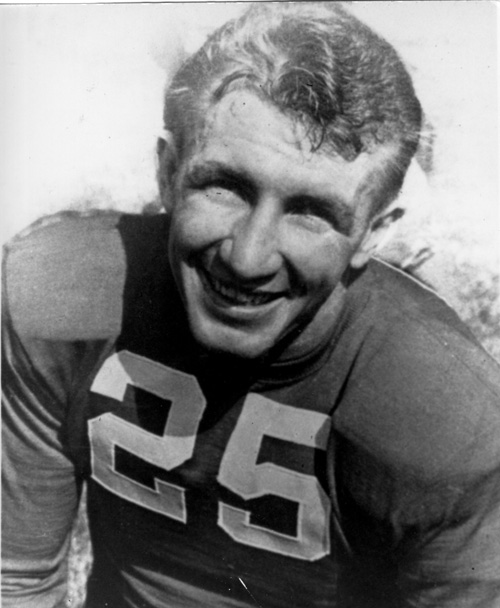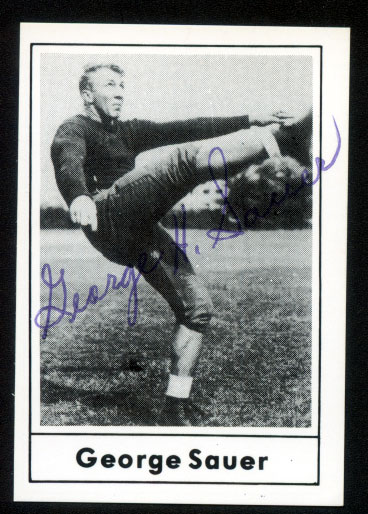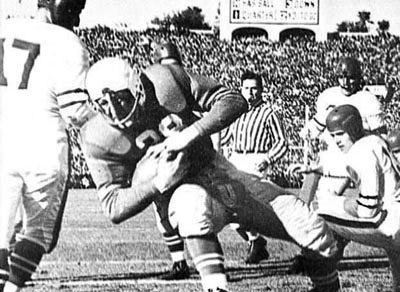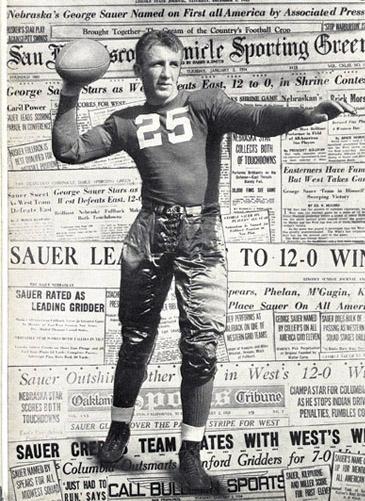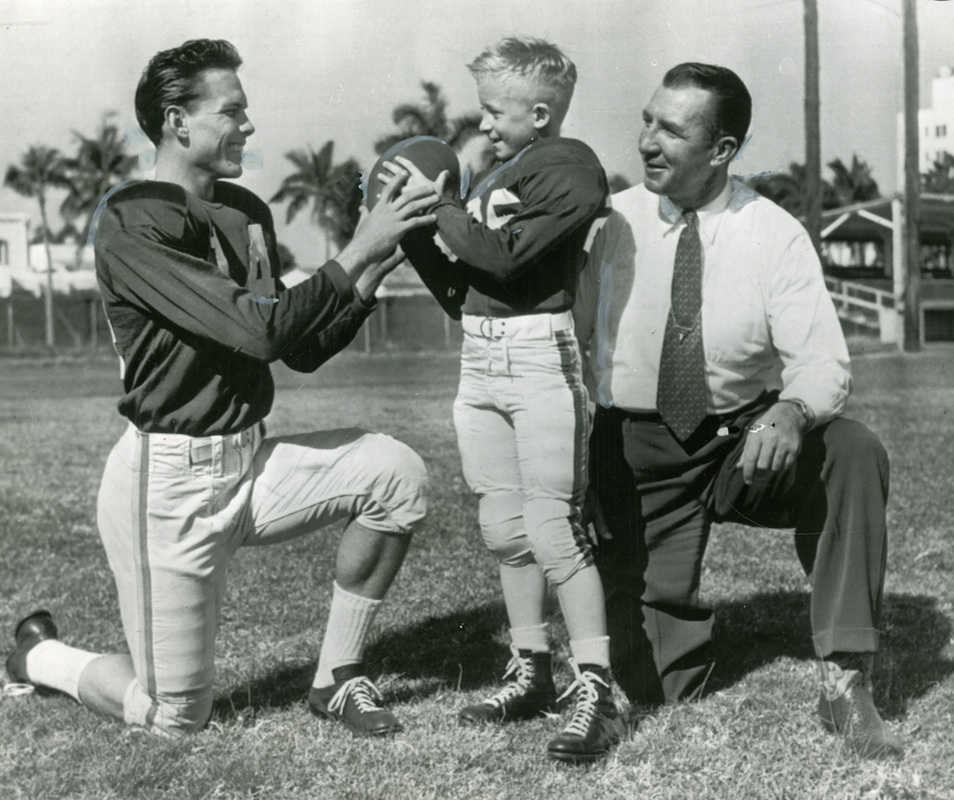People > Notable Norkans > George Henry Sauer, Sr.
George Henry Sauer, Sr.
George Henry Sauer was born in Stratton, Nebraska, on December 11, 1910. George's parents, Ludwig (Louis) and Katherine Sauer, were natives of Norka, Russia.
George and Louis Sauer descend from Johannes Sauer (born about 1744), Ludwig Sauer (born 1790), Johann Nicolaus Sauer (born 1835), and Conrad Sauer (born 1863).
When George was 5, the family moved to Lincoln, settling in the North Bottoms neighborhood. Louis went into the trash collection business.
George Sauer was a member of the Lincoln High School Class of 1929. A great high school athlete in all sports, Sauer played on three state championship football teams (32 wins, 1 loss, 1 tie record) and two state championship track teams.
George and Louis Sauer descend from Johannes Sauer (born about 1744), Ludwig Sauer (born 1790), Johann Nicolaus Sauer (born 1835), and Conrad Sauer (born 1863).
When George was 5, the family moved to Lincoln, settling in the North Bottoms neighborhood. Louis went into the trash collection business.
George Sauer was a member of the Lincoln High School Class of 1929. A great high school athlete in all sports, Sauer played on three state championship football teams (32 wins, 1 loss, 1 tie record) and two state championship track teams.
After high school, Sauer attended the University of Nebraska, where he was one of most revered Cornhusker players during the hard-hit 1930s. As an all-around excellent player who could run, kick, and pass, he often left the competition wondering what he would do next. Sauer quickly became an emulated football hero. Ed Schwartzkopf, a future Nebraska University player, recalled that at the time:
"Everybody wanted to be George Sauer."
Nebraskan kids idolized the Lincoln native, often pressing their mothers to sew George's famous number 25 onto their sweaters. Sauer had a loyal following within the team as well. Coach D.X. Bible glowed when speaking of him:
"He was probably my best all-around athlete. He was great at carrying the ball and he was one of the best on defense. He simply rolled up his sleeves and met the ball carrier head on."
Sauer led Nebraska to Big Six championships in the 1931, 1932, and 1933 conference seasons, during which Nebraska was undefeated and the fullback was all-conference.
In 1932, Sauer was central to the Husker's stellar record of eight wins and only one loss. That solitary loss was to undefeated Pittsburgh. The Husker defensive line, led by Sauer, held off the steel-town squad until the slashing Panthers scored the game's only touchdown in the fourth quarter. Games against big teams like the Panthers brought national attention to the Huskers. Players like Sauer did not go unnoticed. At the end of his senior season, he led the voting for players in the New Year's Day All-Star game. Sauer distinguished himself by intercepting passes and scoring the game's only touchdowns. After the game, news writer Lawrence Perry commented that Sauer "stands clearly as the premier ball carrier in the nation."
While Sauer was best known as an All-America football player, he played four sports at Nebraska: football, basketball, baseball, and track.
After his college career ended, Sauer was signed by the National Football League's Green Bay Packers in 1934, where he played running back for three seasons. Sauer retired from the Packers after winning the league championship in 1936.
After leaving the NFL, Sauer served as the head football coach at the University of New Hampshire from 1937 to 1941.
Sauer interrupted his sports career to serve in World War II, obtaining the rank of lieutenant colonel.
Sauer returned to civilian life to use his considerable football skills and knowledge as the head football coach at the University of Kansas. His 1946 and 1947 teams shared the Big Six title, and he took the Jayhawks to the Orange Bowl game in Miami.
Sauer moved on to the United States Naval Academy (1948-1949), where he became the first civilian coach in over a decade. He resigned from the Navy Academy after two of his assistants were treated unfairly.
From the Naval Academy, he went to Baylor University (1950-1955), where he was named Southwest Conference Coach of the Year in 1950. After six years as head coach, he moved up to Athletic Director.
In 1932, Sauer was central to the Husker's stellar record of eight wins and only one loss. That solitary loss was to undefeated Pittsburgh. The Husker defensive line, led by Sauer, held off the steel-town squad until the slashing Panthers scored the game's only touchdown in the fourth quarter. Games against big teams like the Panthers brought national attention to the Huskers. Players like Sauer did not go unnoticed. At the end of his senior season, he led the voting for players in the New Year's Day All-Star game. Sauer distinguished himself by intercepting passes and scoring the game's only touchdowns. After the game, news writer Lawrence Perry commented that Sauer "stands clearly as the premier ball carrier in the nation."
While Sauer was best known as an All-America football player, he played four sports at Nebraska: football, basketball, baseball, and track.
After his college career ended, Sauer was signed by the National Football League's Green Bay Packers in 1934, where he played running back for three seasons. Sauer retired from the Packers after winning the league championship in 1936.
After leaving the NFL, Sauer served as the head football coach at the University of New Hampshire from 1937 to 1941.
Sauer interrupted his sports career to serve in World War II, obtaining the rank of lieutenant colonel.
Sauer returned to civilian life to use his considerable football skills and knowledge as the head football coach at the University of Kansas. His 1946 and 1947 teams shared the Big Six title, and he took the Jayhawks to the Orange Bowl game in Miami.
Sauer moved on to the United States Naval Academy (1948-1949), where he became the first civilian coach in over a decade. He resigned from the Navy Academy after two of his assistants were treated unfairly.
From the Naval Academy, he went to Baylor University (1950-1955), where he was named Southwest Conference Coach of the Year in 1950. After six years as head coach, he moved up to Athletic Director.
Sauer compiled a career college football record of 78 wins, 55 losses, and 9 ties.
In 1961, Sauer became the General Manager of the New York Titans of the American Football League. Beginning in 1963, the Titans changed their name to the New York Jets, and Sauer served as Director of Player Personnel. In January 1969, the Jets won Super Bowl III over the Baltimore Colts. Sauer's son, wide receiver George Sauer Jr., was Joe Namath's favorite target that day.
Sauer was inducted into the College Football Hall of Fame as a player in 1954, the Nebraska Sports Hall of Fame in 1964, and the Nebraska High School Sports Hall of Fame in 1995.
George Henry Sauer, Sr. died in Waco, Texas, on February 5, 1994.
In 1961, Sauer became the General Manager of the New York Titans of the American Football League. Beginning in 1963, the Titans changed their name to the New York Jets, and Sauer served as Director of Player Personnel. In January 1969, the Jets won Super Bowl III over the Baltimore Colts. Sauer's son, wide receiver George Sauer Jr., was Joe Namath's favorite target that day.
Sauer was inducted into the College Football Hall of Fame as a player in 1954, the Nebraska Sports Hall of Fame in 1964, and the Nebraska High School Sports Hall of Fame in 1995.
George Henry Sauer, Sr. died in Waco, Texas, on February 5, 1994.
Sources
Krieger, Jerry. "George Sauer Enshrined in National Football Hall of Fame". Norka Newsletter. Summer 2000.
George Sauer Statistics at Nebraska
Wikipeida.com
Nebraska Cornhuskers Athletics article on George Sauer
Nebraska High School Sports Hall of Fame Foundation
College Football Hall of Fame
George Sauer Statistics at Nebraska
Wikipeida.com
Nebraska Cornhuskers Athletics article on George Sauer
Nebraska High School Sports Hall of Fame Foundation
College Football Hall of Fame
Last updated December 8, 2023
